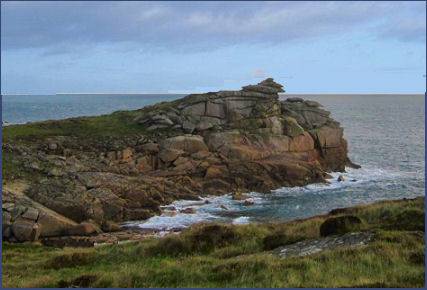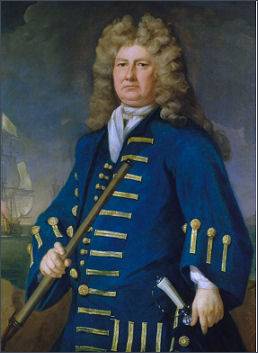Porth Hellick Bay
OS grid reference :- SV 925 105
 Porth Hellick Bay is situated on the south coast of the Island of St. Mary's, the largest of the Isles of Scilly.
Porth Hellick Bay is situated on the south coast of the Island of St. Mary's, the largest of the Isles of Scilly.
To the south stands the headland known as the Giant's Castle (pictured left), a cliff fort dating to the Iron Age. The 'castle' has several low and closely spaced lines of 'defence' that divide the rocky headland from Salakee Down. The rocky promontory that has been sculpted by the wind and tides into fantastic shapes. Porth Hellick Down and Porth Hellick Point lie to the north of the cove.
 The beach is sand and rock. At low tide a wide expanse of sand and rocks are exposed and a bar of fine shingle provides a barrier from the sea. The only stream in the islands rises in Holy Vale and flows through
Higher Moors to the sea at Porth Hellick.
The beach is sand and rock. At low tide a wide expanse of sand and rocks are exposed and a bar of fine shingle provides a barrier from the sea. The only stream in the islands rises in Holy Vale and flows through
Higher Moors to the sea at Porth Hellick.
A Stone memorial to the curiously named Admiral of the Fleet Sir Cloudesley Shovell (right) stands at the top of the beach, where his body was washed up after the wreck of his flagship HMS Association following the 1707 Scilly naval disaster. A squadron of 21 ships, returning to England from Toulon in thick fog and gathering darkness, when they struck rocks to the west of the Isles of Scilly. Four ships, Association, Firebrand, Romney and Eagle were lost and over 1,400-2,000 sailors lost their lives and it was one of the worst disasters of the Royal Navy. Shovell was temporarily buried on the beach and although he was largely responsible for the disaster, by order of Queen Anne his body was later exhumed, embalmed and taken to London where he was interred in Westminster Abbey.
There is a story that he was still alive when his body was washed up at Porth Hellick and he was killed by a local woman for the emerald ring he wore on his finger. Twenty years afterwards, she is said to have confessed on her deathbed and the local priest sent the ring to one of Shovell's friends, the Earl of Berkeley.
The area is known for its migrating and wintering birds and was designated as the Higher Moors and Porth Hellick Pool (St Mary's) Site of Special Scientific Interest (SSSI) in 1971.
 Higher Moors and Porth Hellick
Pool is one of the three main freshwater wetland areas on the Scilly Isles. A small steam flows into the wetland forming a mosaic of willow and alder scrub, mire and pools. Reed Warbler and Sedge Warbler nest in the common reed which grows along the margins of the pools and Coot, Gadwall, Mallard and Moorhen, Teal and Water Rail also sighted.
Higher Moors and Porth Hellick
Pool is one of the three main freshwater wetland areas on the Scilly Isles. A small steam flows into the wetland forming a mosaic of willow and alder scrub, mire and pools. Reed Warbler and Sedge Warbler nest in the common reed which grows along the margins of the pools and Coot, Gadwall, Mallard and Moorhen, Teal and Water Rail also sighted.
The fields have a rich wet grassland flora with Greater Tussock-sedge, Hemlock Water-dropwort, Purple Loosestrife, Royal Fern, Water Mint and Yellow Iris. The acidic boggy areas support Bog Pimpernel, Bog Stitchwort and Marsh St John's-wort with Lesser Spearwort in the wetter areas.
Porth Hellick Entrance Grave which dates from about 2000 BC is the largest in a scattered cemetery that includes six others, and two low cairns. Entrance graves are perhaps the most impressive of Bronze Age monuments, and the example at Porth Hellick Down is typical in its design. It consists of a near-circular mound, about 39 feet (12m) in diameter and up to 5 feet (1.6m) high, which is retained by a kerb of stone slabs. The Great Tomb was excavated in 1899 by George Bonsor, but only Bronze Age pottery was found and he reported that the tomb had already been cleared out.
The Scilly naval disaster of 1707
 On 22 October 1707, during the War of the Spanish Succession, a British naval fleet was sunk off the Isles of Scilly. Four large ships were lost and more than 1,400 sailors lost their lives, it was referred to as one of the worst maritime disasters in the history of Britain.
On 22 October 1707, during the War of the Spanish Succession, a British naval fleet was sunk off the Isles of Scilly. Four large ships were lost and more than 1,400 sailors lost their lives, it was referred to as one of the worst maritime disasters in the history of Britain.
A British fleet led by the Commander-in-Chief, Sir Cloudesley Shovell (right), was returning from the Mediterranean, having attacked Toulon in aid of Prince Eugene of Savoy, the British force had managed to inflict damage on the French fleet in the siege. Their passage home, however, was marked by severe weather and constant squalls and gales. As the squadron entered the mouth of the English Channel, the bad weather and fog caused the mariners to incorrectly calculate their longitude, they were unaware that they were off course and approaching the Isles of Scilly. Before this mistake could be corrected, the fleet struck rocks and four ships were sunk.
The exact number of officers and sailors who were killed in the sinking of the four ships is not known. Estimates vary between 1,400 and over 2,000. In the days that followed, bodies continued to wash onto the shores of the islands along with the wreckage of the warships and personal effects. Many of the dead sailors from the wrecks were buried on the island of St Agnes.
The circumstances of Sir Cloudesley Shovell's death never been discovered. His body and the bodies of both his stepsons and that of Edmund Loades, captain of the Association, were all washed up at Porthellick Cove the following day, almost seven miles from where his ship foundered, the most likely scenario is that Shovell left his ship in one of its lifeboats, along with his two Narborough stepsons, Edmund Loades, and a pet dog and that they were drowned while trying to get to shore. Shovell's body was identified by the Purser of HMS Arundel who knew him well and identified him by "a black mole under his left ear, also by the first joint of one of his forefingers being broken inwards. He had likewise a shot in his right arm, another in his left thigh".
The circumstances under which his remains were found gave rise to several stories. It was rumoured that Shovell was still alive, at least just, when he reached Porthellick Cove, but was killed by a local woman who was eager to acquire his priceless emerald ring which had been given to him by his close friend, Captain James Lord Dursley. At this time, the Scillies had acquired a reputation for being wild and lawless. Edmund Herbert, who was sent to Scilly in 1709 by Shovell's family wrote that Sir Cloudesley's body was first discovered by two women "stript of his shirt" and "his ring was also lost off his hand, which however left ye impression on his finger". Shovell's widow Elizabeth had offered a large reward for the recovery of any family property.
Another legend concerning the disaster states that a sailor onboard the flagship attempted to warn Shovell that the fleet was off course but was hanged at the yardarm for inciting mutiny. The story first appeared in the Scilly Isles in 1780 with the sailor being a Scilly native who recognized the waters but was punished. The myth was embellished in the nineteenth century when the punishment became instant execution.
The wreck site was rediscovered in 1964 by the Naval Air Command Sub Aqua Club. Members of the club recovered gold coins, a bronze cannon and many other artefacts from the Association site.